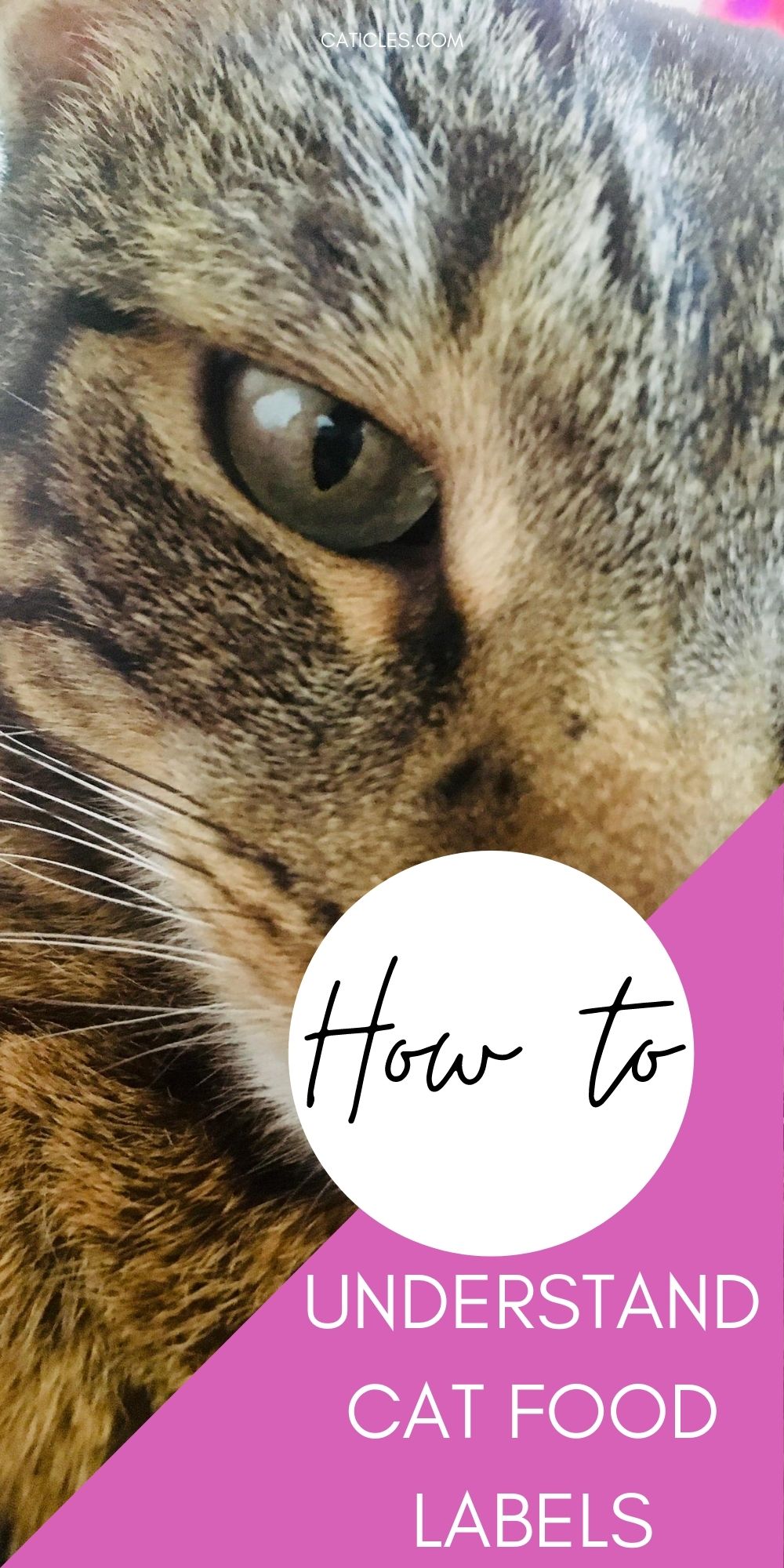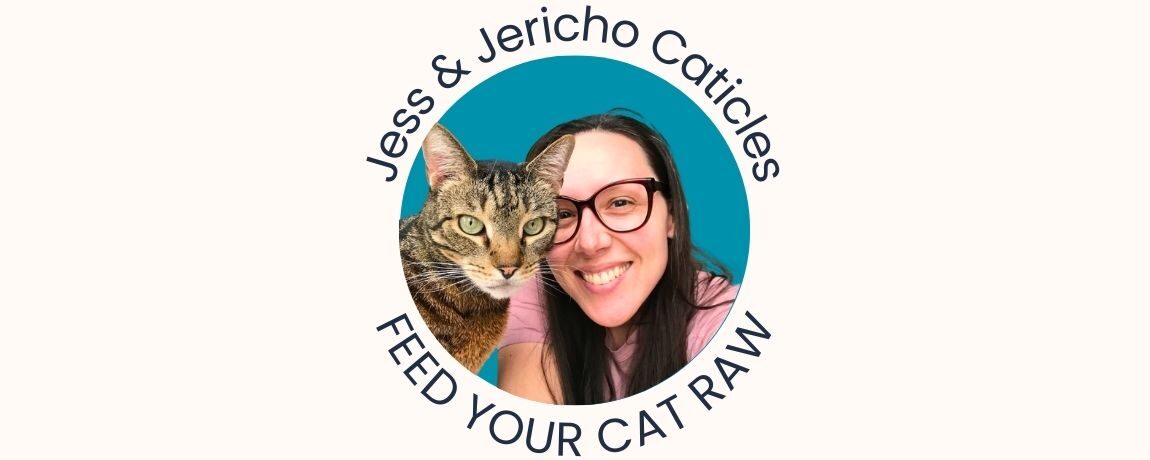Is wet cat food bad for cats?
Wet cat food is definitely better than kibble. It has more moisture, and cats need this from their food. But, wet cat food isn’t that much better. Most brands are owned by the same corporations that make junk for humans. So, you’ll see the same questionable ingredients in their wet cat food.

This post does not contain affiliate links. However, other articles on my website do. Please read my full disclaimer.
Also, nothing I say is medical advice. I took all of these photos at my local pet store.
What’s the difference between kibble and wet cat food?
The main difference between kibble and wet cat food is moisture content.
Kibble is typically around 10% moisture. Wet cat food is around 75%.
Unfortunately, most of the time, the ingredients are the same.
Mysterious crap.
At the end of the day, these companies are in business to make money.
So, it’s your responsibility to provide the best nutrition for your cats.
The best diet for cats is a raw homemade diet.
- It mimics their natural diet
- High in moisture
- Meat-only protein
- You control the ingredients and how it’s made
Wet food contains:
- Thickening agents
- Grains and carbs
- More vegetable and grain proteins than meat
- Highly processed mystery ingredients
Cats are obligate carnivores. Meaning, they are restricted to a meat-only diet.
They cannot utilize carbs. So, carbs are not essential to the diet.
Fat provides more than twice as much energy.
Plants do not contain essential amino acids. So, a high amount of grains, vegetables, and fruits is unnecessary.
But, if you absolutely have to feed commercial cat food…
And your choices are down to kibble and wet canned food…
Wet canned food will always be better than kibble. Simply because there’s more moisture.
Cats rely on food for moisture. Even if your cat drinks a lot of water.
I’ve gathered the most popular wet cat food brands below.
Some brands have many different options, but they use the same crap ingredients.
Hopefully, this will show you that a balanced homemade diet is best.
Here’s a closer look at 27 different wet cat food options:
- Understanding pet food labels
- Hill’s Science Diet
- Blue Buffalo
- Nature’s Variety Instinct
- Purina/Merrick/Castor and Pollux/Whole Earth Farms/Fancy Feast
- Royal Canin
- Weruva/B.F.F./Soulstice
- Applaws
- Natural Balance
- Tiki Cat
- Solid Gold
- Wellness
- Whole Hearted
Tip: Read more about cat nutritional needs in my kibble guide.
Check out this guide today or save THIS PIN to your Cat Food board on Pinterest.
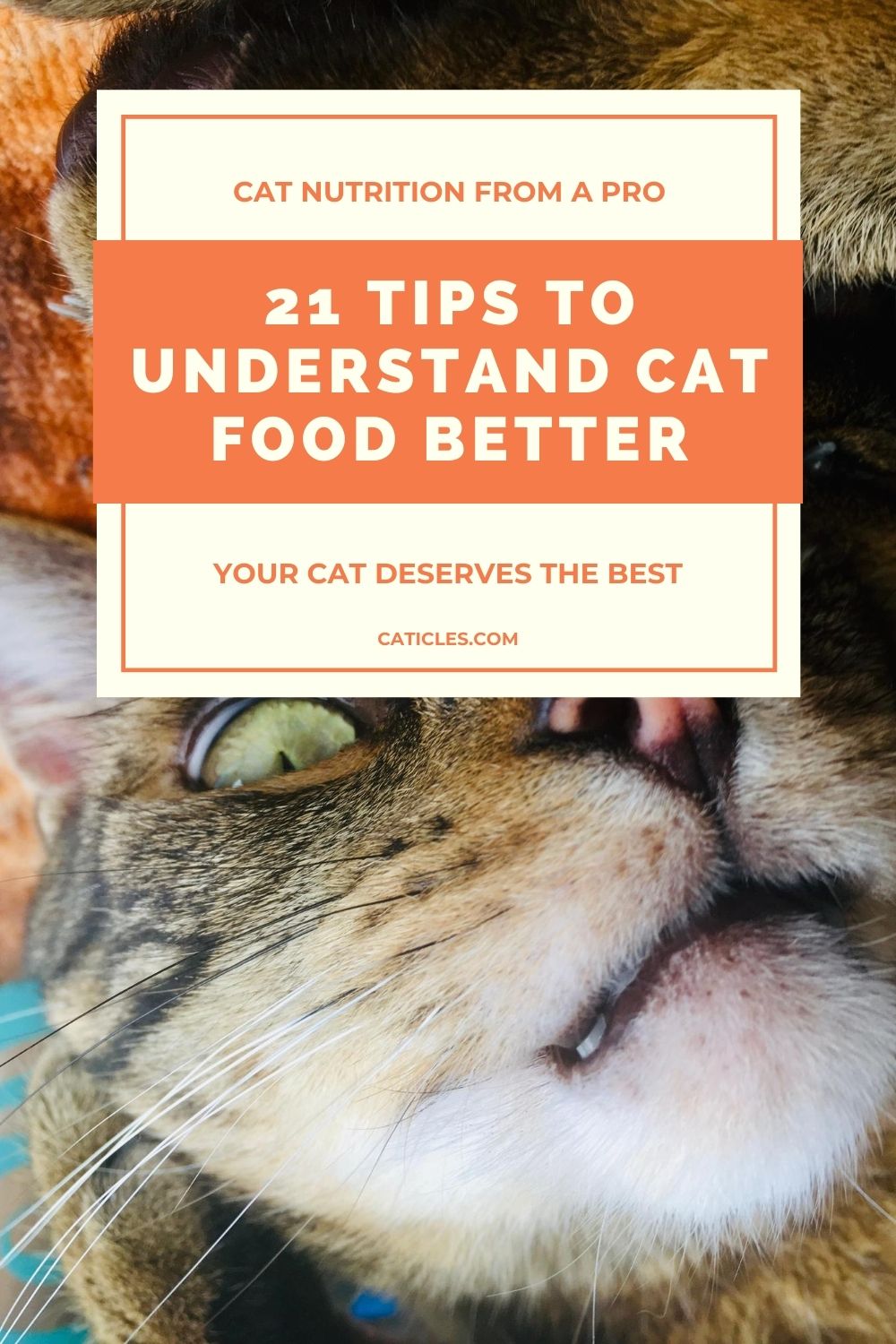
Understanding pet food labels
First, we must understand how to read cat food labels.
Why?
Because there are many rules in place when it comes to the pet food product label.
The FDA does not regulate the quality of cat food. They establish standards for the proper identification of product labels based on AAFCO rules.
AAFCO does not approve cat food.
Read that again.
Straight from the FDA:
“The product name can be a key factor in the consumer’s decision to buy the product. For that reason, manufacturers often use fanciful names or other techniques to emphasize a particular aspect of the product… The pet food label contains a wealth of information, if one knows how to read it. Do not be swayed by the many marketing gimmicks or eye-catching claims.”
Rules:
- “Tuna Cat Food” = 95% rule
- Not counting water, at least 95% of the food must be tuna
- Counting water, at least 70% of the food must be tuna
- “Chicken and Tuna Cat Food” = 2 named ingredients must be 95% of the total weight combined. There must be more chicken than tuna, however, since it is named first
- “Tuna Dinner for Cats” = 25% rule
- Not counting water, at least 25% of the food must be tuna
- Counting water, at least 10% of the food must be tuna
- Other descriptive words in this rule: platter, entree, nuggets, formula, recipe
- “Chicken n’ Fish Dinner Cat Food” = 2 named ingredients must be 25% of the total weight combined with at least 3% fish
- “Cat Food with Tuna” = 3% rule
- “with” indicates a minimum requirement of 3% tuna
- “Chicken Flavor Cat Food” = no minimum requirement for chicken
- Only enough of it needs to be added to detect a flavor
- More often it is another substance that gives the flavor such as chicken meal or chicken by-products
- May also contain “chicken digests”, meaning no actual chicken is added. But they are still allowed to call the food “Chicken Flavor Cat Food”
- “Premium” = Unlike natural and organic, “premium” is an unregulated term in feed law
- “Stew” = more moisture than usual
- Other words “in sauce” “in gravy” and anything similar
- Moisture is great, but meat is important
Ingredients:
- Must be added in order of predominance by weight
- Weight is determined as they are added, including water content
- Muscle meat is approximately 75% water. Meaning, most of the meat weight is just water
- Meat and meat byproducts = potentially from dead, dying, diseased, or disabled animals
- Discarded by the USDA because it’s not fit for human consumption
- Meat meal = rendered product from mammal tissues
- “Exclusive of any added blood, hair, hoof, horn, hide trimmings, manure, stomach and rumen contents except in such amounts as may occur unavoidably in good processing practices“
- Cellulose = inexpensive plant fibers
- Also includes: beet pulp, buckwheat, grain hulls, flaxseed, fruit pectin, guar gum, oat and other brans, peanut shells, psyllium, tomato pomace, and powdered cellulose
- This extra fiber can inhibit digestion and absorption of vital nutrients
- Peas = pulse crops
- Gluten and grain-free (used as marketing gimmicks)
- Used to bump up the protein content
- Carnivores can’t break these down properly
- May contribute to GI disturbances and leaky gut
- Brewers dried yeast = waste product of beer and ale industry
- Can become toxic to the liver
- Rice = cheap filler product
- Can cause obesity and diabetes
- Wheat = cheap gimmicky filler
- Can cause allergies, digestive upset, and bowel problems
- Corn = cheap filler product
- Breaks down into sugar which can cause obesity and diabetes
- May contain deadly aflatoxin mold
- A culprit of many allergies
- Soy = cheap source of grain protein
- Can cause bowel irritation
- Carrageenan = thickening agent
- Food-grade carrageenan causes GI inflammation
- Higher rates of intestinal lesions, ulcerations, and even malignant tumors
- Xanthan Gum = thickening agent
- Made using carbs from corn, wheat, dairy, or soy
- Can cause allergic reactions and diarrhea in sensitive individuals
- Synthetic vitamins and minerals and “natural” preservatives = provides no nourishment
- Cheaper than fresh meat nutrients
From AAFCO:
“Under the broader definition for byproducts, which includes ingredients like meat and bone meal, yes, certain carcasses or parts may be rejected from use for humans and processed into animal feed. Meat and meat byproducts not directly suitable for animal food that are designated as 4-D (dead, dying, diseased or disabled). These are considered adulterated—unless processed in a manner that rids them of disease-causing microorganisms prior to becoming animal feed. This is most often done by rendering, which subjects the materials to heat and pressure to eliminate harmful bacteria.”
Ok, so they get rid of bacteria by cooking it to death. But, what about medicinal drugs in the animal’s system?
AAFCO has many definitions for ingredients.
Reading your cat’s food label isn’t only about the ingredients. Small changes in the product name alter the ingredient amounts tremendously.
Also, the FDA and AAFCO don’t have regulatory authority over pet food.
Further information
Within each section, I’ve named the parent companies for each brand.
Why?
Most brands will say “super-premium”, “finest healthy ingredients”, or “cooked with love in our USA kitchen” to sell their products.
But, if each product is the “best”, why are there so many different products within the same brand?
Why are these brands owned by huge corporation conglomerates?
Where is the personal connection?
Why do these conglomerates own so many different brands that all promise the same thing?
Let’s take a closer look…
Hill’s Science Diet
- Parent company: Hill’s Pet Nutrition, Inc. a subsidiary of Colgate-Palmolive Company
- Toothpaste and body wash products
- Proof
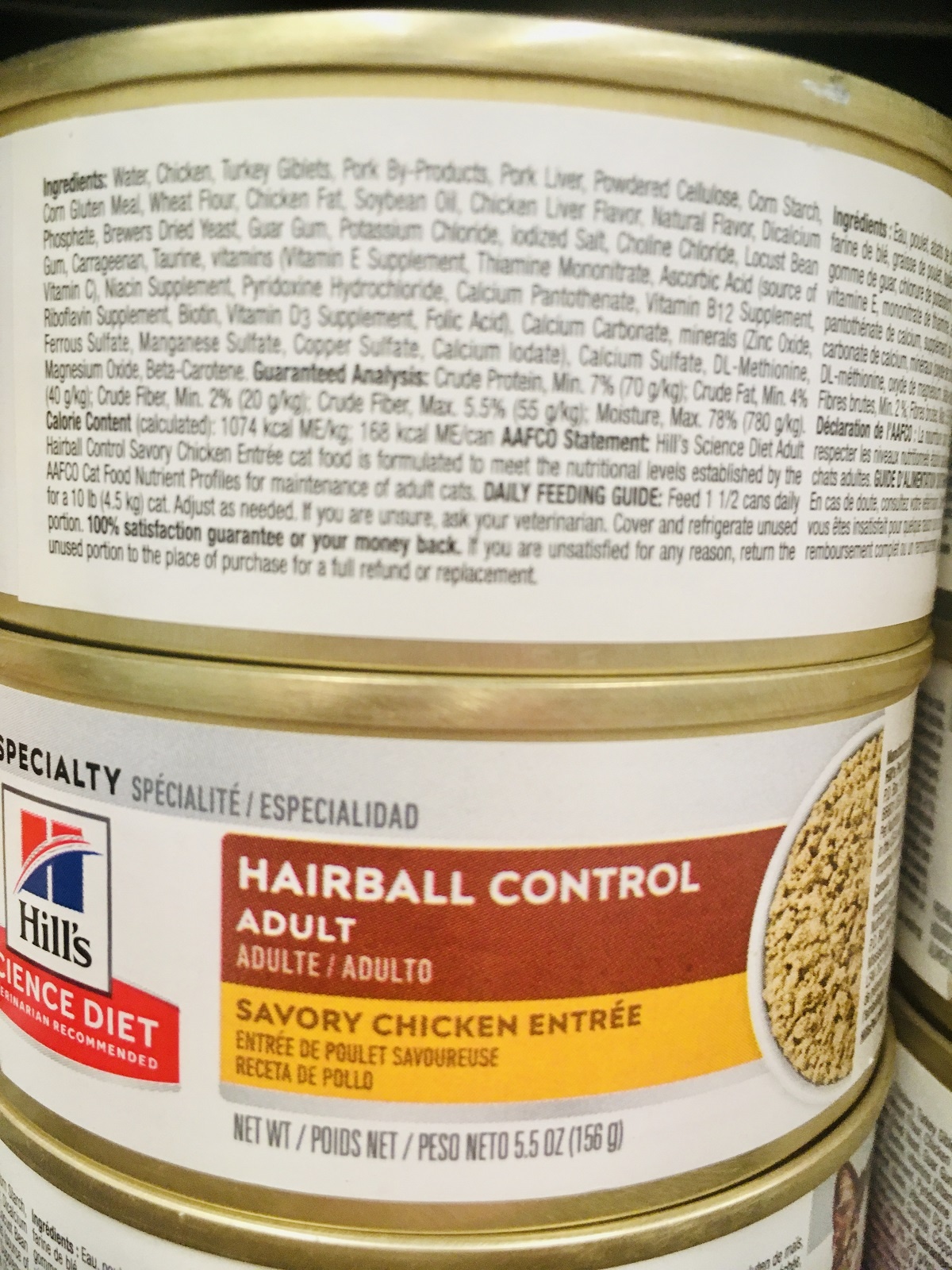
- Product name: Hairball Control Adult Savory Chicken Entree
- Entree = 25% rule
- Meat ingredients = chicken, turkey giblets, pork by-products, pork liver, chicken fat, chicken liver flavor
- Other ingredients = powdered cellulose, corn starch, corn gluten meal, wheat flour, soybean oil, natural flavor, brewers dried yeast, guar gum, locust bean gum, carrageenan, and the rest are vitamins and minerals (most of which are synthetic)
There are fewer meat ingredients than other ingredients.
I thought cats require a meat-only diet to be healthy?
How can this help hairball control when most of the ingredients are indigestible for cats?
Would you ever suspect that “chicken entree” means chicken plus turkey and pork and a bunch of grains and carbs?
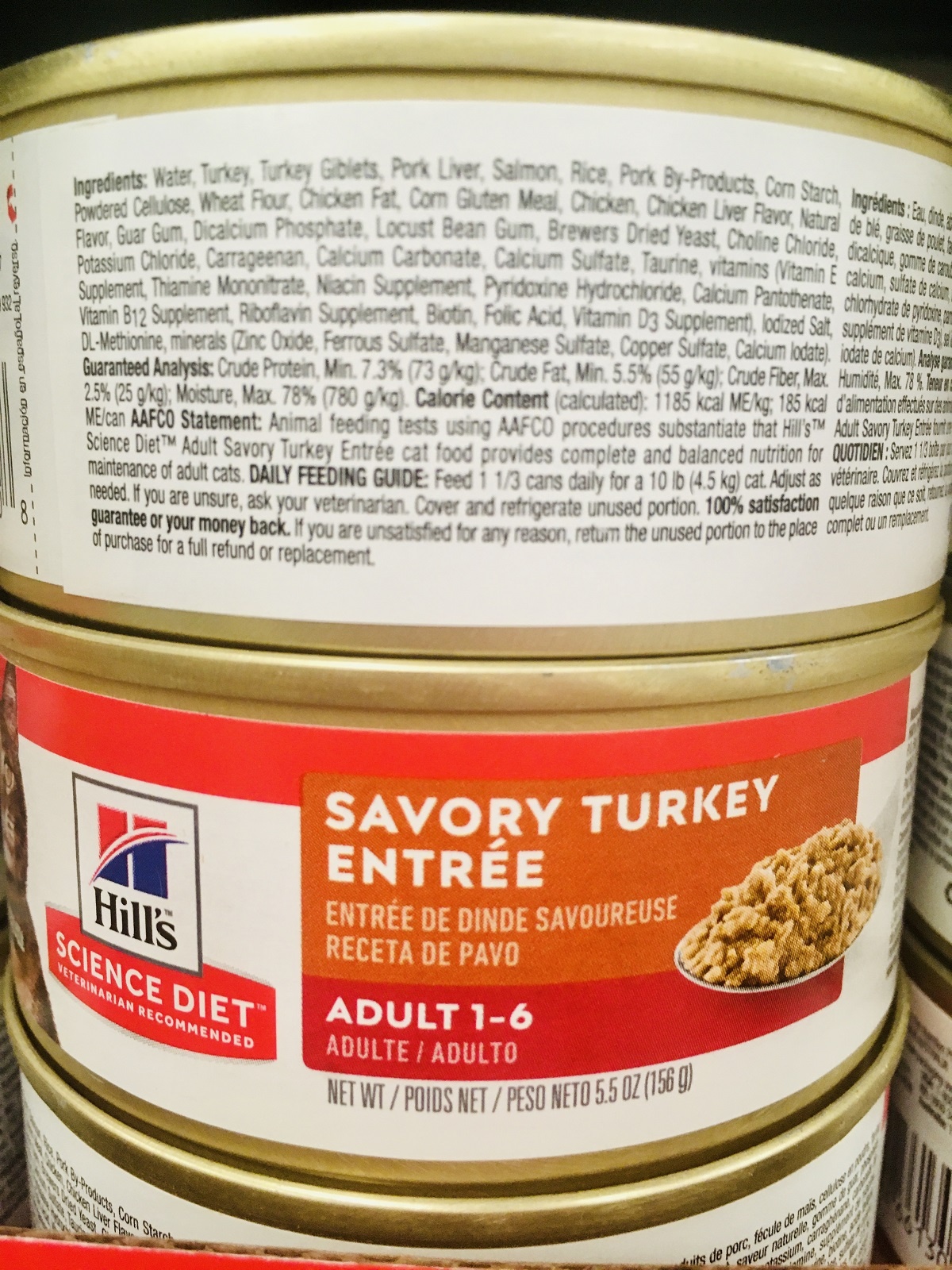
- Product name: Savory Turkey Entree Adult
- Entree = 25% rule
- Meat ingredients = turkey, turkey giblets, pork by-products, pork liver, salmon, chicken fat, chicken, chicken liver flavor
- Other ingredients = rice, powdered cellulose, corn starch, corn gluten meal, wheat flour, natural flavor, brewers dried yeast, guar gum, locust bean gum, carrageenan, and the rest are vitamins and minerals (most of which are synthetic)
Pretty much the same ingredients here.
What makes the previous one better for hairball control?
Would you ever suspect “turkey entree” means turkey plus pork, salmon, chicken, cheap grains, and thickeners?
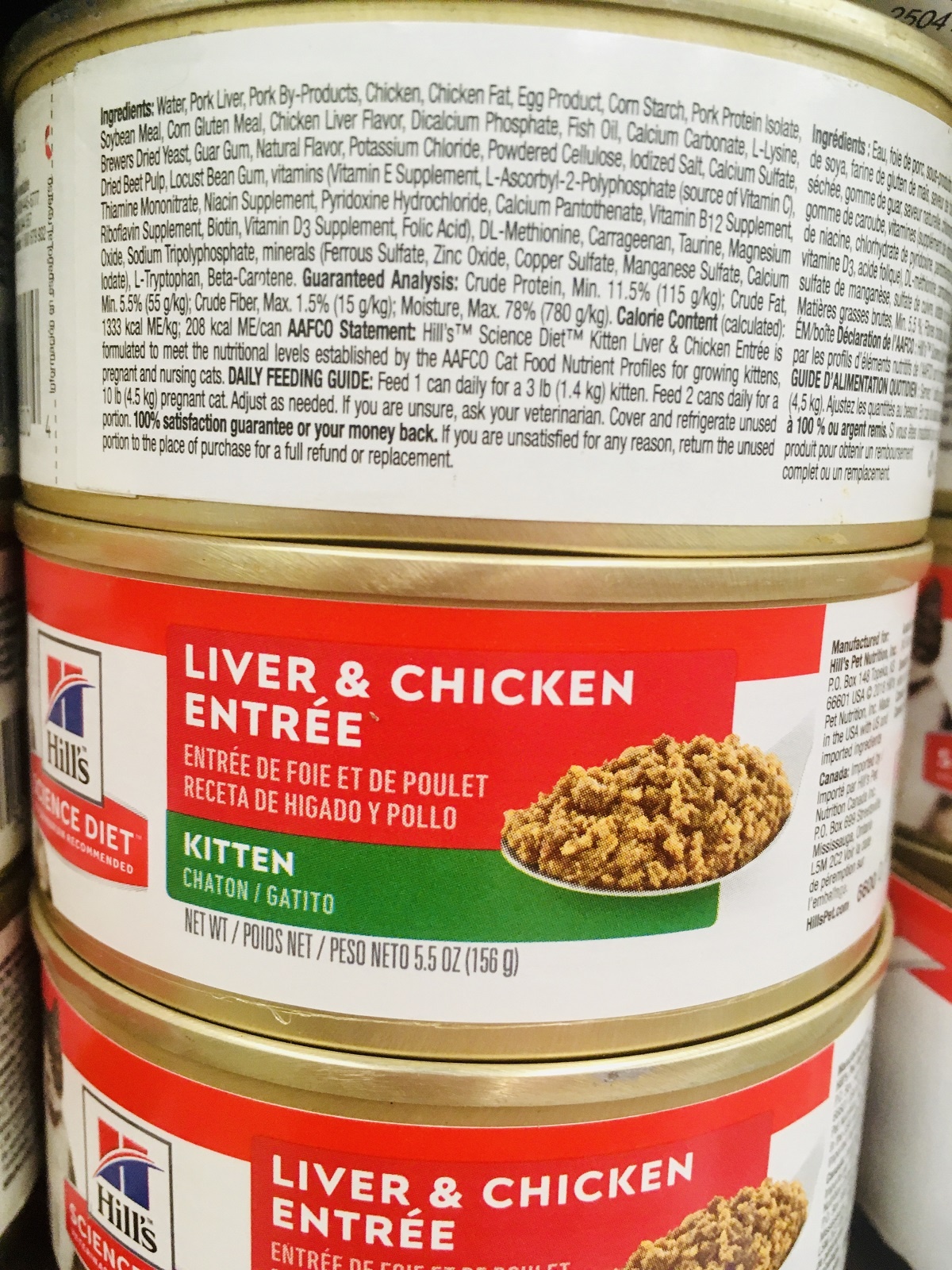
- Product name: Liver & Chicken Entree Kitten
- Entree = 25% rule
- Meat ingredients = pork liver, pork by-products, chicken, chicken fat, pork protein isolate, chicken liver flavor
- Other ingredients = corn starch, soybean meal, powdered cellulose, dried beet pulp, corn gluten meal, natural flavor, brewers dried yeast, guar gum, locust bean gum, carrageenan, and the rest are vitamins and minerals (most of which are synthetic)
Hm.. pretty much the same ingredients here too.
But it’s meant for kittens?
What makes this one different?
Blue Buffalo
- Parent company: General Mills
- Global food company
- Proof and more proof
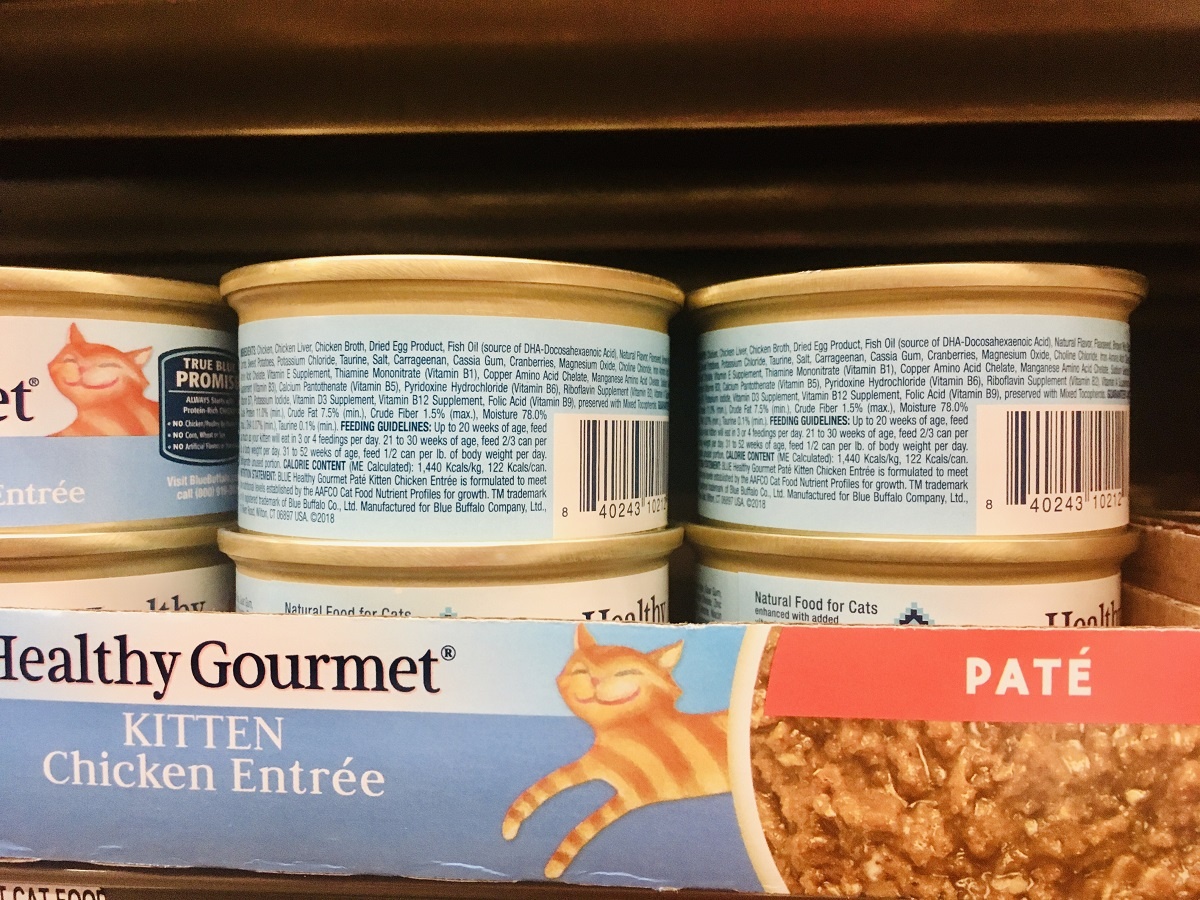
- Product name: Healthy Gourmet Kitten Chicken Entree
- Entree = 25% rule
- Meat ingredients = chicken, chicken liver, chicken broth
- Other ingredients = dried egg product, natural flavor, flaxseed, brown rice, guar gum, carrots, sweet potatoes, carrageenan, cassia gum, cranberries, and the rest are vitamins and minerals (most of which are synthetic)
“Healthy”? This is mostly carbs, thickeners, and other ingredients cats can’t digest.
How can kittens grow appropriately if this food is filled with junk?
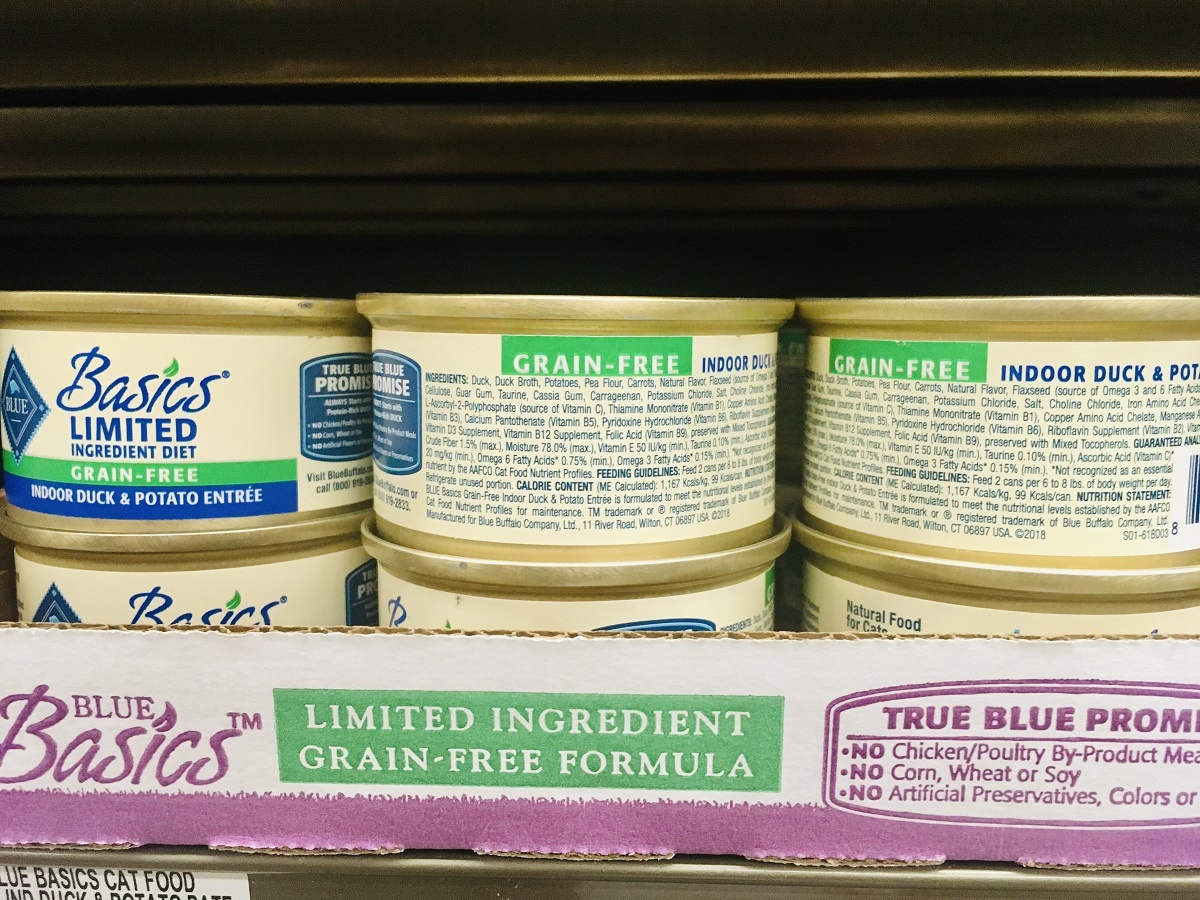
- Product name: Blue Basics Limited Ingredient Grain-Free Formula Duck & Potato Entree
- Entree = 25% rule, combined ingredients so that means even less duck
- Meat ingredients = duck, duck broth
- Other ingredients = potatoes, pea flour, carrots, natural flavor, flaxseed, pumpkin, cranberries, blueberries, powdered cellulose, guar gum, cassia gum, carrageenan, and the rest are vitamins and minerals (most of which are synthetic)
Limited ingredient? Seems like an ironic name to me…
The food claims grain-free, but that does not mean carb-free.
Potatoes, pea flour, and pumpkin are all high in carbs.
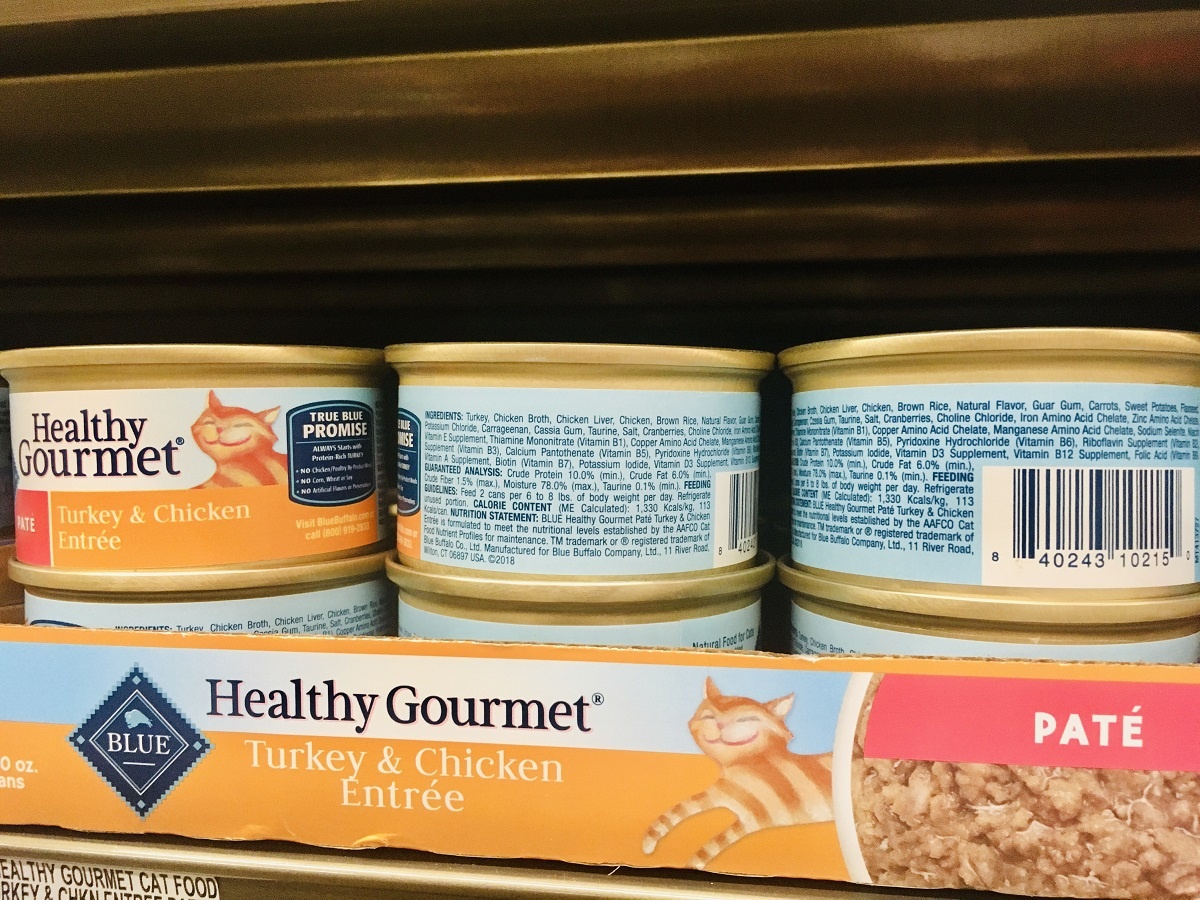
- Product name: Healthy Gourmet Turkey & Chicken Entree
- Entree = 25% rule, combined ingredients so that means less of each meat
- Meat ingredients = turkey, chicken broth, chicken liver, chicken
- Other ingredients = brown rice, natural flavor, guar gum, carrots, sweet potatoes, flaxseed, carrageenan, cassia gum, and the rest are vitamins and minerals (most of which are synthetic)
Very similar ingredients to the kitten food.
So, why do they market them as a different product?
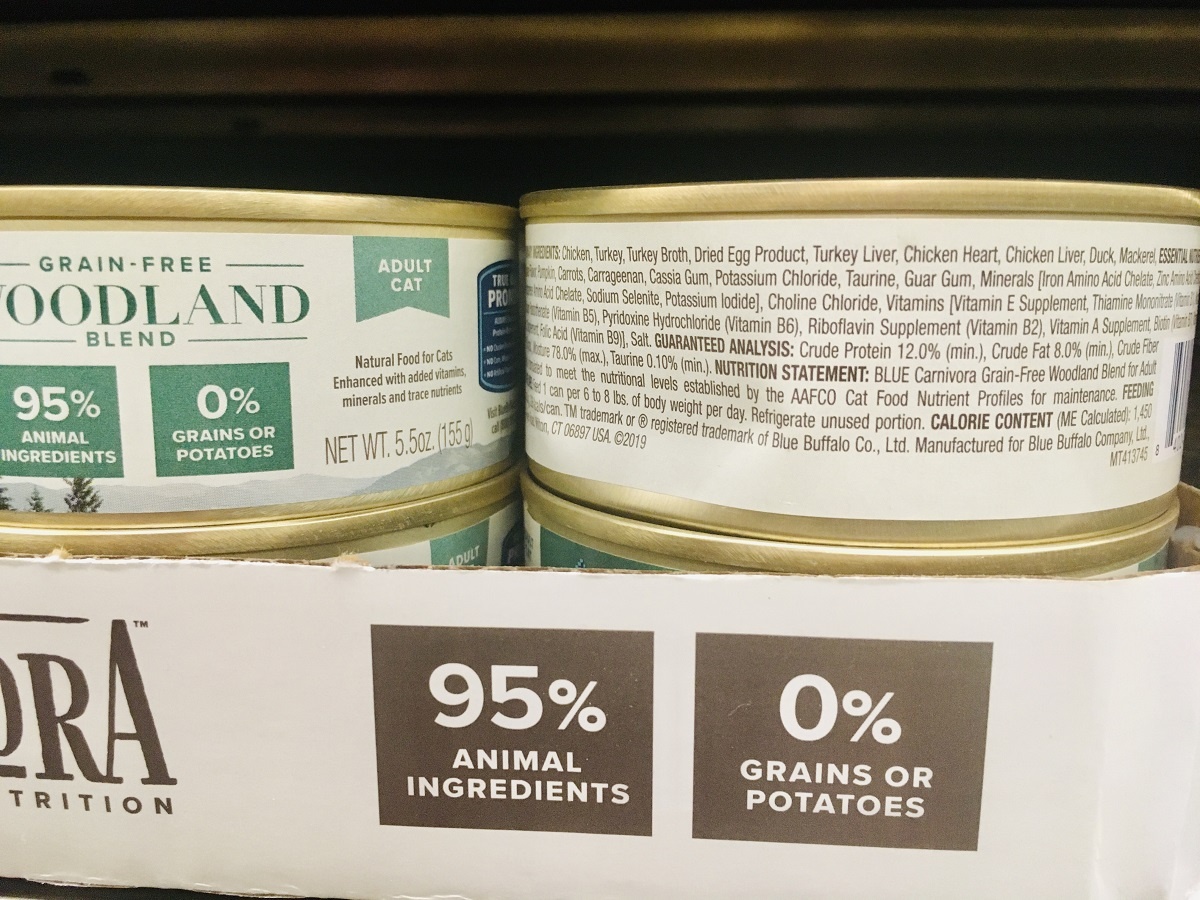
- Product name: Carnivora Woodland Blend Grain-Free Adult
- No product name rule requirements
- Meat ingredients = chicken liver, duck, mackerel
- Other ingredients = natural flavor, pumpkin, carrots, carrageenan, cassia gum, guar gum, and the rest are vitamins and minerals (most of which are synthetic)
If they don’t include a product name rule, how do we know how much meat is in it?
This particular brand of Blue Buffalo says “carnivore” but there’s more than just meat.
They boast 0% grains or potatoes, but pumpkin has carbs.
Are you starting to notice their clever marketing tricks?
Nature’s Variety Instinct
- Parent company: MI Industries
- Livestock and other animal food manufacturing
- Proof and more proof
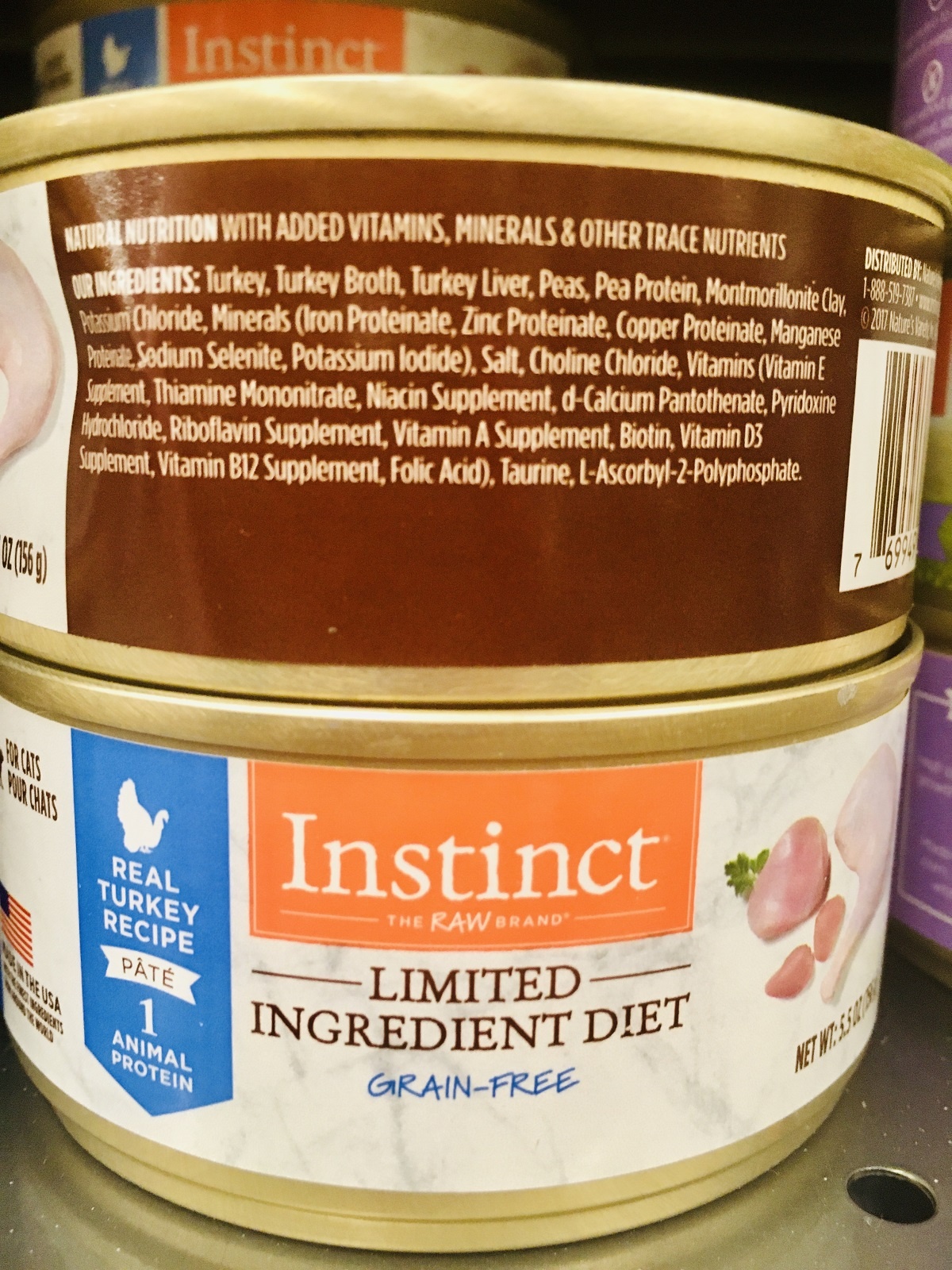
- Product name: Instinct Limited Ingredient Diet Grain-Free Real Turkey Recipe
- Recipe = 25% rule
- Meat ingredients = turkey, turkey broth, turkey liver
- Other ingredients = peas, pea protein, montmorillonite clay, and the rest are vitamins and minerals (most of which are synthetic)
Sure, we see fewer ingredients in this food. But, the minimum requirement for turkey is only 25%.
If there were more turkey, they would name their product differently based on AAFCO rules.
And why are peas and pea protein listed separately?
If the pea ingredients were grouped, they’d probably outweigh the turkey ingredients.
That would push turkey further down the list. And, pet food companies know that we want to see meat as the first ingredient.
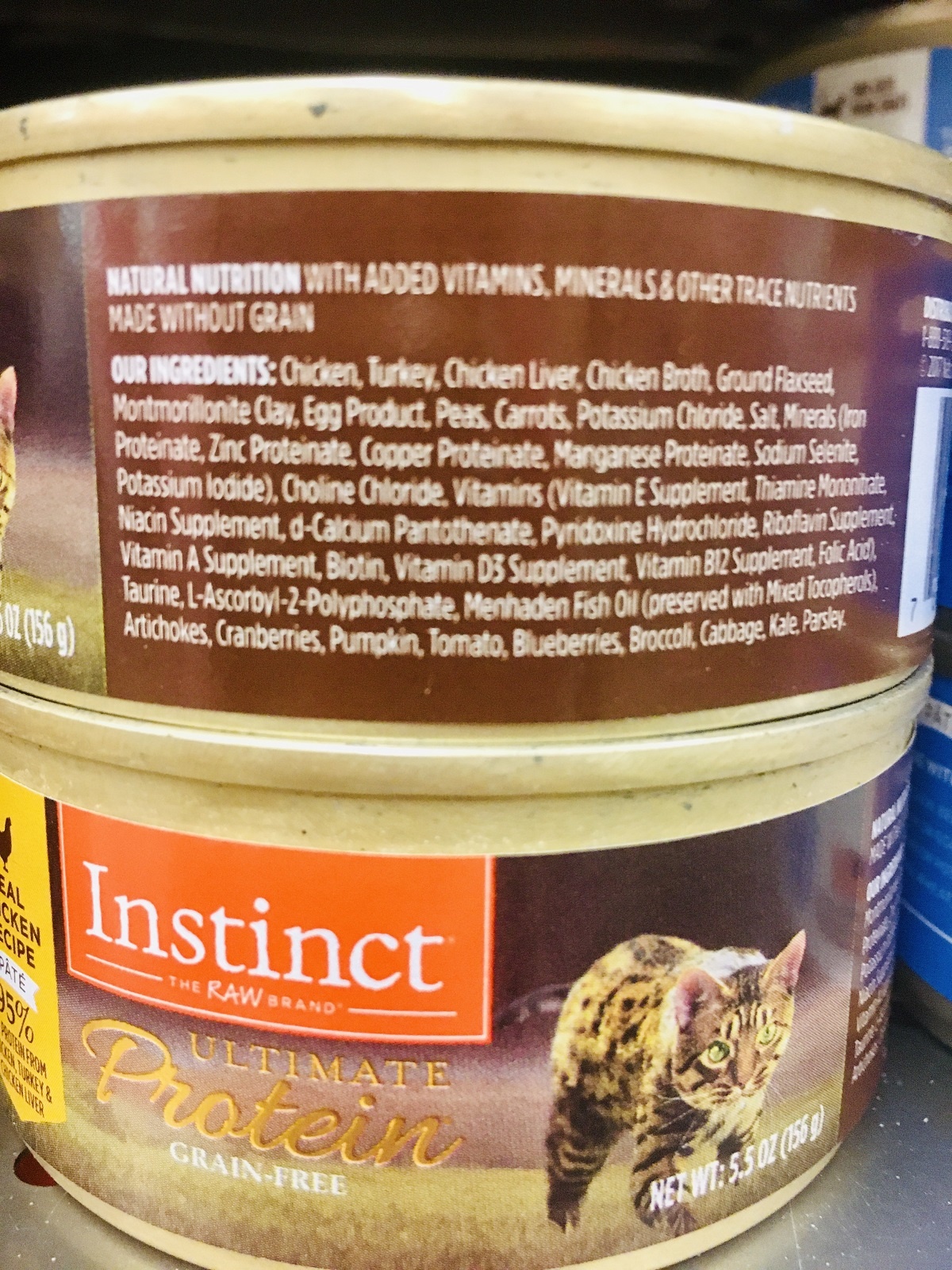
- Product name: Instinct Ultimate Protein Grain-Free Real Chicken Recipe
- Recipe = 25% rule
- Meat ingredients = chicken, turkey, chicken liver, chicken broth
- Other ingredients = ground flaxseed, montmorillonite clay, egg product, peas, carrots, artichokes, cranberries, pumpkin, tomato, blueberries, broccoli, cabbage, kale, parsley, and the rest are vitamins and minerals (most of which are synthetic)
95% protein from real chicken and turkey? Why are there more vegetables and fruits than meat?
Plus, if there was more chicken than veggies/fruits, the name would be “Real Chicken Cat Food” not “Chicken recipe”.
Always go by the label rules, not the marketing claims.

- Product name: Kitten Grain-Free Real Chicken Recipe
- Recipe = 25% rule
- Meat ingredients = chicken, beef liver, chicken broth, salmon
- Other ingredients = eggs, montmorillonite clay, dried kelp, artichokes, cranberries, pumpkin, tomato, blueberries, broccoli, cabbage, kale, parsley, and the rest are vitamins and minerals (most of which are synthetic)
Again, these ingredients aren’t much different.
I wonder why this one has “eggs” and the previous lists “egg product”.
Purina/Merrick/Castor and Pollux/Whole Earth Farms/Fancy Feast
- Parent company: Nestle Purina
- Multinational food and drink processing conglomerate corporation
- Proof, proof, and more proof
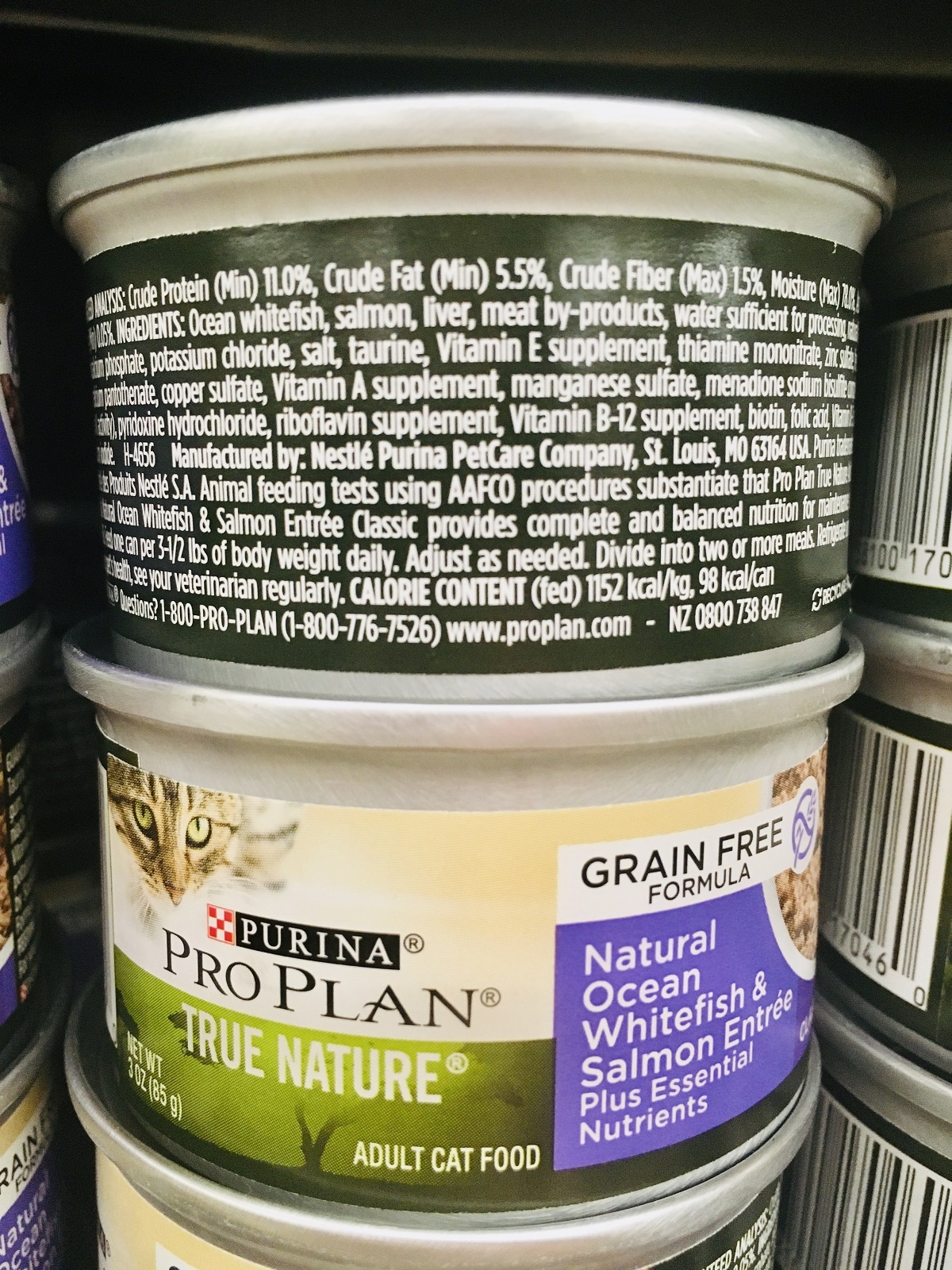
- Product name: Grain-Free Formula Natural Ocean Whitefish & Salmon Entree
- Entree = 25% rule
- Meat ingredients = ocean whitefish, salmon, liver, meat by-products
- Other ingredients = natural flavors, guar gum, and the rest are vitamins and minerals (most of which are synthetic)
This one has fewer ingredients. But, there’s still a mystery.
“Liver” doesn’t indicate the animal from which it originates. Also, “meat by-products” isn’t descriptive either.
Essentially, this means a mixture of multiple animal scraps. Like bologna.
Just throw all the scraps together. They won’t know.
We’ll put something like “true nature” on the can.
If that’s not enough, we’ll also throw in “grain-free” to grab their attention.
Purina accounts for many different brands of cat food. And they’re some of the worst cat food brands.
Need help feeding your picky cat better? My switch your cat to raw course is for you!

- Product name: Grain-Free Free-Range Turkey Recipe Morsels in Gravy
- Recipe = 25% rule
- Meat ingredients = organic turkey, chicken broth, organic chicken liver, chicken
- Other ingredients = dried egg whites, organic dried peas, organic carrots, organic cranberries, organic apples, natural flavor, guar gum, and the rest are vitamins and minerals (most of which are synthetic)
From AAFCO:
“Organic regulations specific for pet foods are currently being developed. In the interim, the NOP has said that pet foods claiming to be organic must meet its human food regulations. Certified organic foods will display a USDA organic seal and must be made of at least 95% organic ingredients.”
So, we know that the minimum requirement of turkey is only 25%. If there were more turkey, the product name would be different.
This package does not have the USDA organic seal. That means it doesn’t meet the 95% organic ingredients minimum.
But, 6 of the ingredients say organic.
It seems this food is mostly broth and synthetic vitamins and minerals.
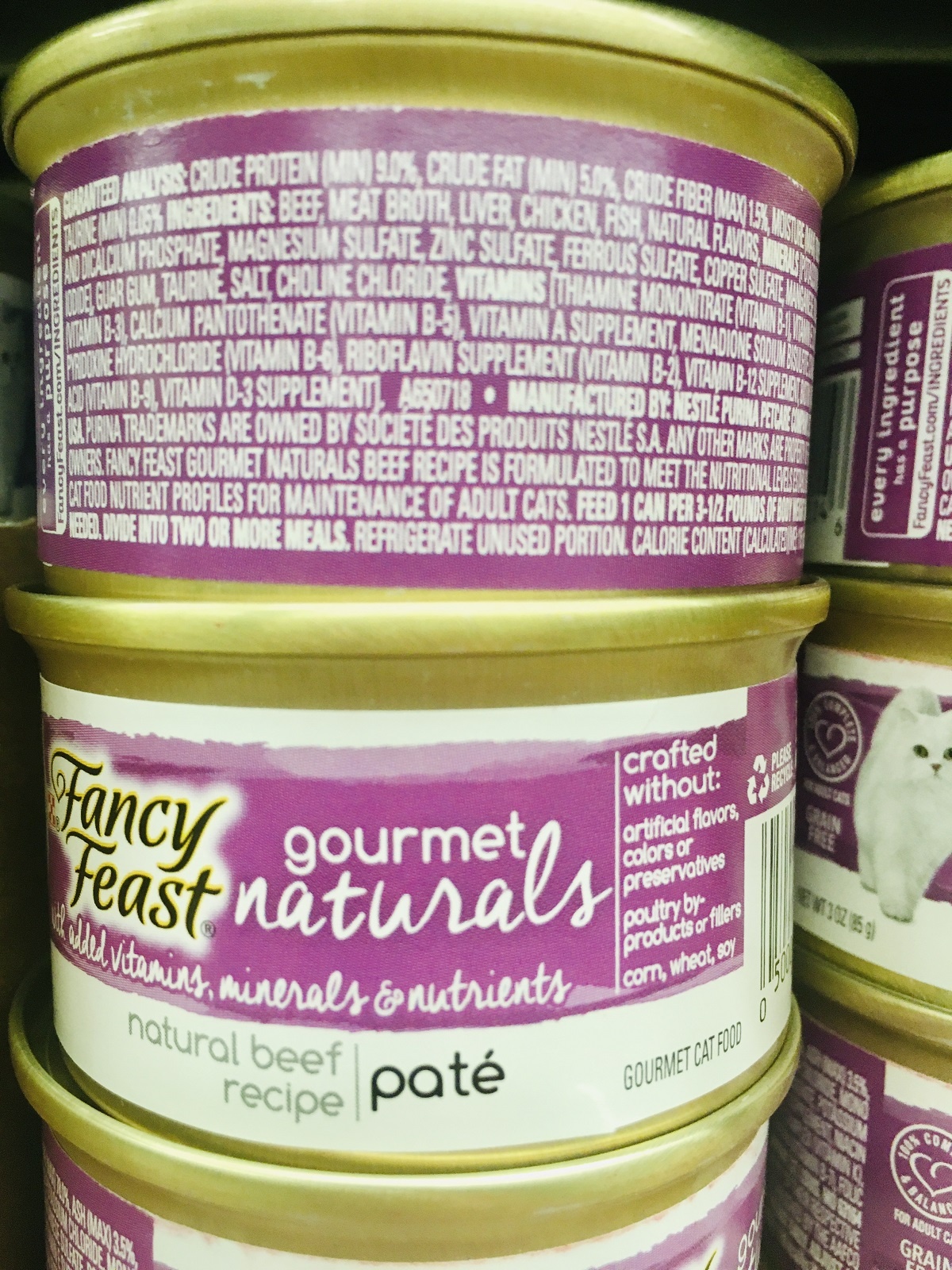
- Product name: Gourmet Naturals Beef Recipe
- Recipe = 25% rule
- Meat ingredients = beef, meat broth, liver, chicken, fish
- Other ingredients = natural flavors, guar gum, and the rest are vitamins and minerals (most of which are synthetic)
“Meat broth” “liver” and “fish”? 3/5 of the meat ingredients are a complete mystery. Wonderful.
Royal Canin
- Parent company: Mars
- Consumer goods like sugary crap
- Proof and more proof
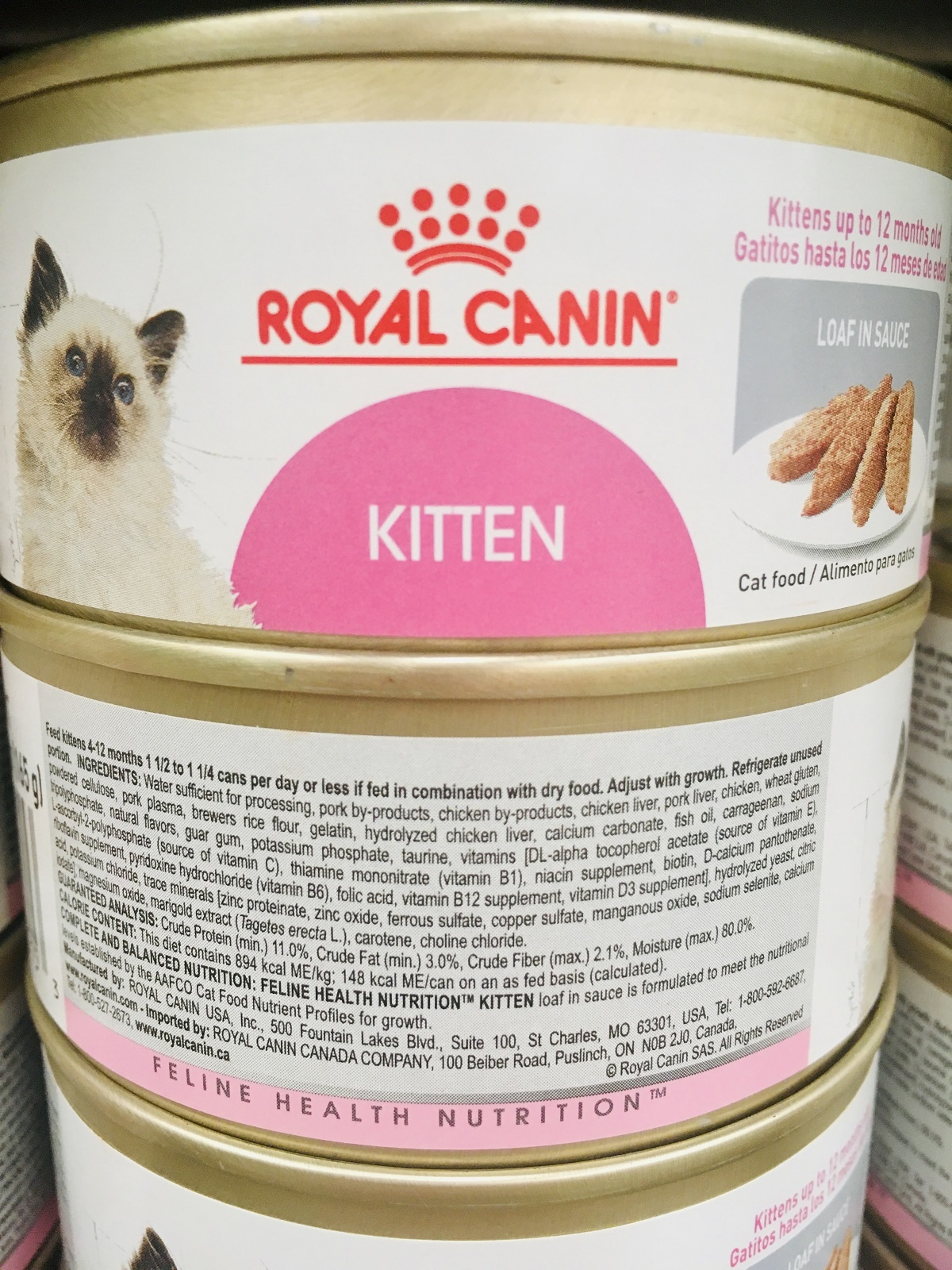
- Product name: Kitten Loaf in Sauce
- No product label rule requirements
- Meat ingredients = pork by-products, chicken by-products, chicken liver, pork liver, chicken, pork plasma, hydrolyzed chicken liver
- Other ingredients = wheat gluten, powdered cellulose, brewers rice flour, gelatin, carrageenan, hydrolyzed yeast, and the rest are vitamins and minerals (most of which are synthetic)
“Loaf in sauce”? Would you eat something with that name?
Anything hydrolyzed means MSG.
But, MSG does not need to be listed as an ingredient because the hydrolyzed ingredients already contain it when added to the food.

- Product name: Adult Loaf in Sauce
- No product label rule requirements
- Meat ingredients = pork by-products, chicken by-products, chicken liver, pork liver, pork plasma, hydrolyzed chicken liver
- Other ingredients = wheat gluten, powdered cellulose, brewers rice flour, gelatin, carrageenan, carob bean gum, guar gum, and the rest are vitamins and minerals (most of which are synthetic)
Doesn’t look much different than the kitten food.
Now, why would they market two identical foods differently? ????
Weruva/B.F.F./Soulistic
- Parent company: Weruva
- Cat and dog products
- Proof and more proof

- Product name: Stew’s Clues Turkey, Chicken, & Salmon Dinner in Gravy
- Dinner = 25% rule and we have a combination so that means even less meat
- Meat ingredients = turkey broth, turkey, chicken, salmon
- Other ingredients = natural flavor, tapioca starch, guar gum, and the rest are vitamins and minerals (most of which are synthetic)
The moisture is 85% which means there’s more turkey broth than actual meat in this food.
Moisture is important, but so is meat.
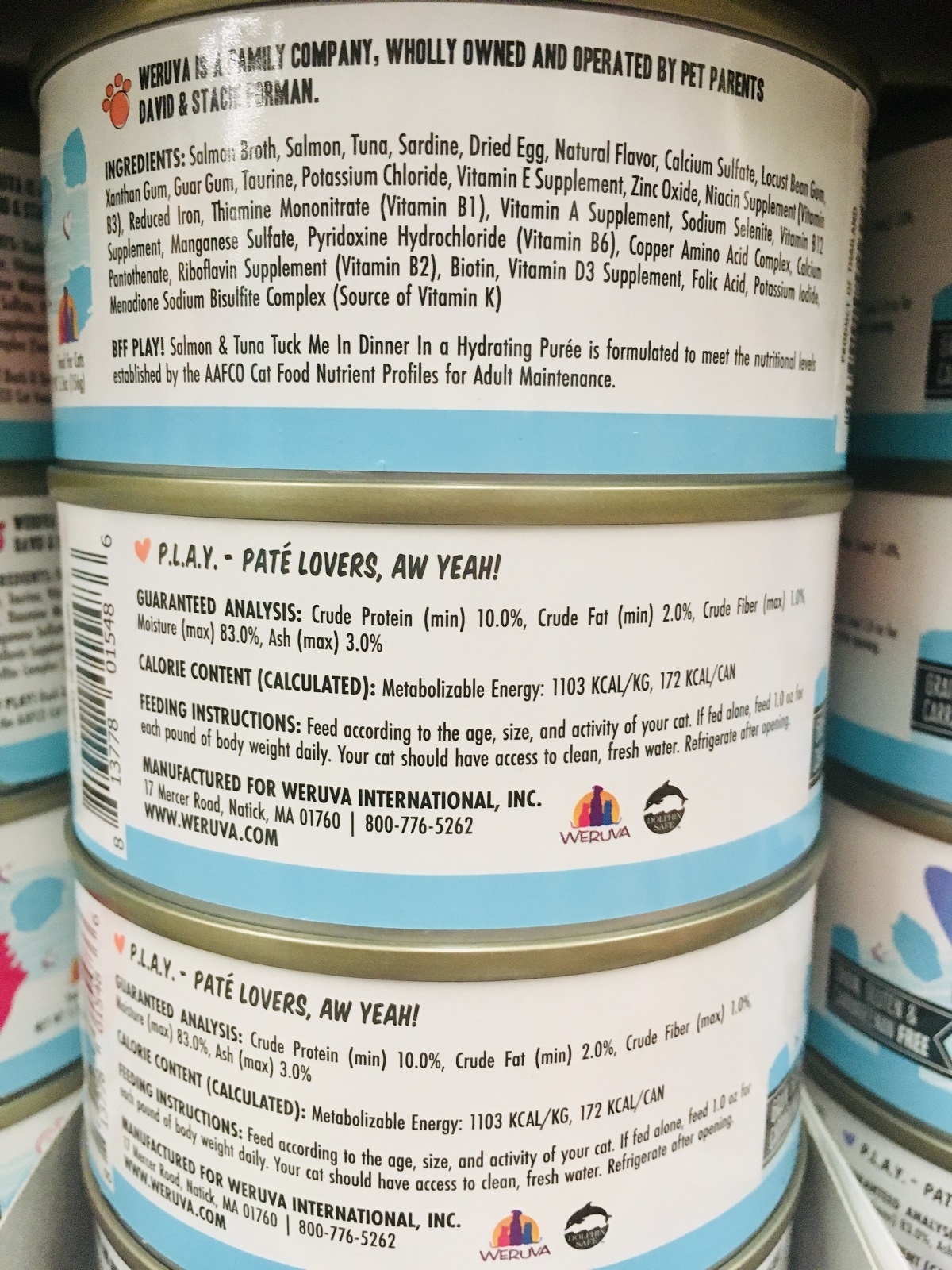
- Product name: Salmon and Tuna Tuck Me in Dinner
- Dinner = 25% and we have a combination so that means even less meat
- Meat ingredients = salmon broth, salmon, tuna, sardine
- Other ingredients = dried egg, natural flavor, locust bean gum, xanthan gum, guar gum, and the rest are vitamins and minerals (most of which are synthetic)
Isn’t it clever that they make cute little names to distract from the label rules?
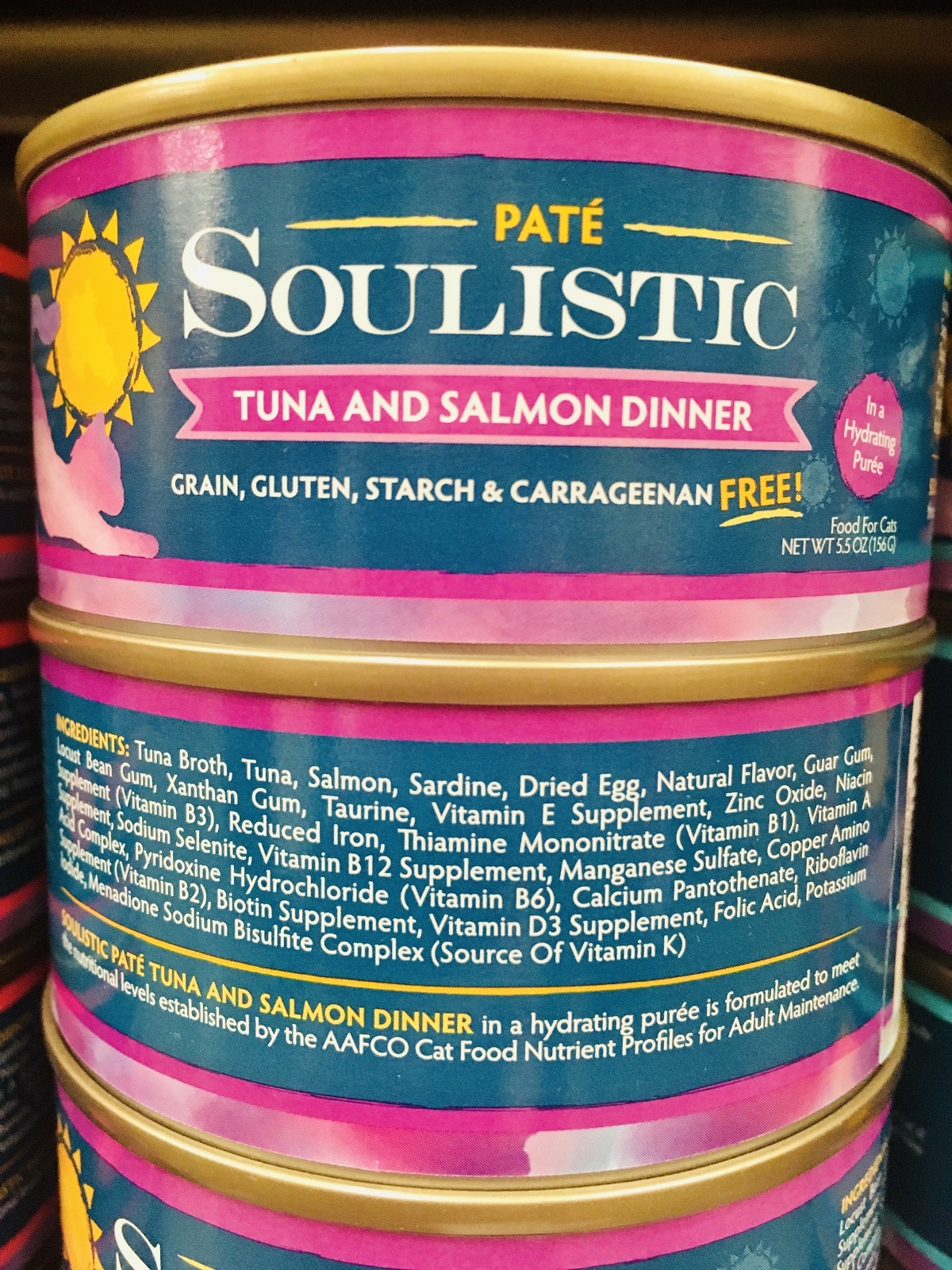
- Product name: Tuna and Salmon Dinner
- Dinner = 25% and we have a combination so that means even less meat
- Meat ingredients = tuna broth, tuna, salmon, sardine
- Other ingredients = dried egg, natural flavor, locust bean gum, xanthan gum, guar gum, and the rest are vitamins and minerals (most of which are synthetic)
Oh, look, the same ingredients under a different brand label!
Applaws
- Parent company: MPM Products
- Cat and dog products
- Proof
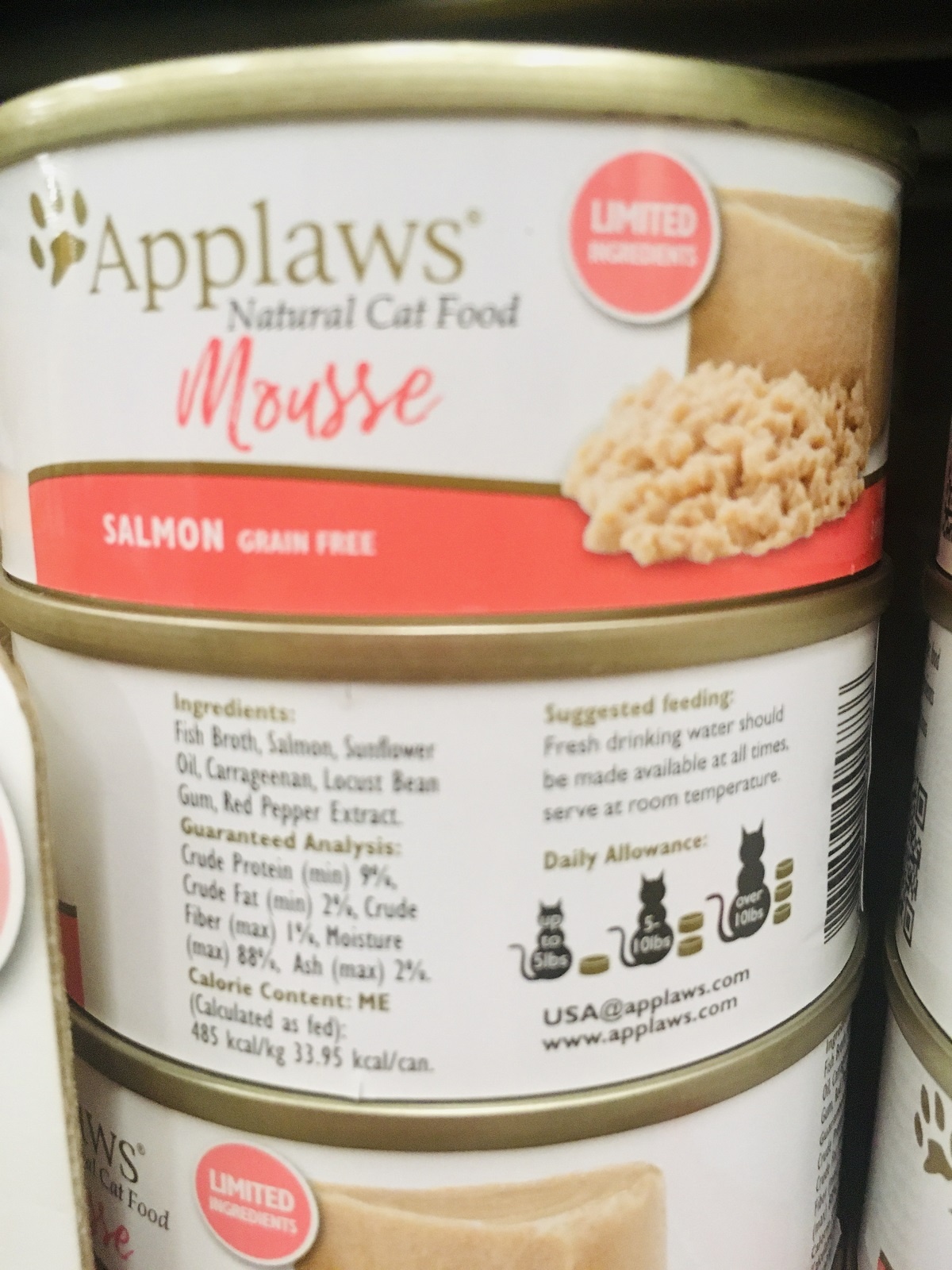
- Product name: Limited Ingredient Mousse Salmon
- No product name rule requirements
- Meat ingredients = fish broth, tuna
- Other ingredients = sunflower oil, carrageenan, locust bean gum
They are right with limited ingredients. But, “fish broth” is very vague.
This food states it’s complementary pet food. Meaning, it does not meet nutrient requirements for a full meal.
Natural Balance
- Parent company: JM Smucker
- They also own Dunkin Donuts, Crisco, Kibbles n Bits, Meow Mix, 9Lives, Rachel Ray’s Nutrish, and many others
- Proof
Gotta love that “natural” in the name.
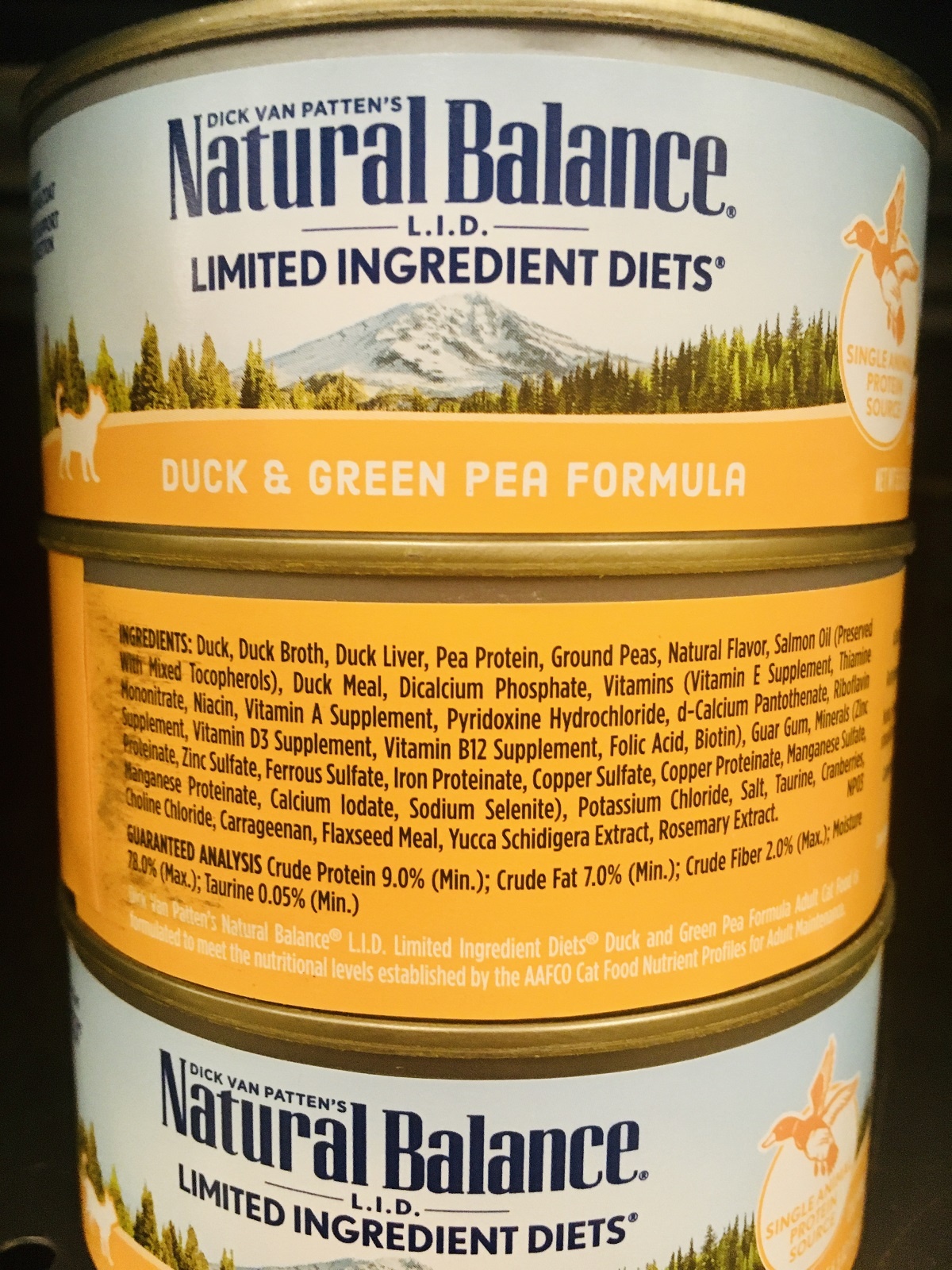
- Product name: Limited Ingredient Duck & Green Pea Formula
- Formula = 25% rule and a combination so that means less meat
- Meat ingredients = duck, duck broth, duck liver, duck meal
- Other ingredients = pea protein, ground peas, natural flavor, guar gum, carrageenan, cranberries, flaxseed meal, yucca schidigera extract, and the rest are vitamins and minerals (most of which are synthetic)
Limited ingredients?

- Product name: Limited Ingredient Indoor Cat Salmon and Chickpea Formula
- Formula = 25% rule and a combination so that means less meat
- Meat ingredients = salmon broth, salmon, salmon meal
- Other ingredients = chickpeas, peas, pea protein, natural flavor, pea fiber, guar gum, carrageenan, cranberries, flaxseed meal, inulin, yucca schidigera extract, and the rest are vitamins and minerals (most of which are synthetic)
So, exchange duck for salmon and pea for chickpeas basically, and you have the same food. Oh, but there’s also peas in this one.
I love how they market this one for “indoor cats” as if outdoor cats are completely different animals.
Moving cats indoors doesn’t change their nutritional needs.
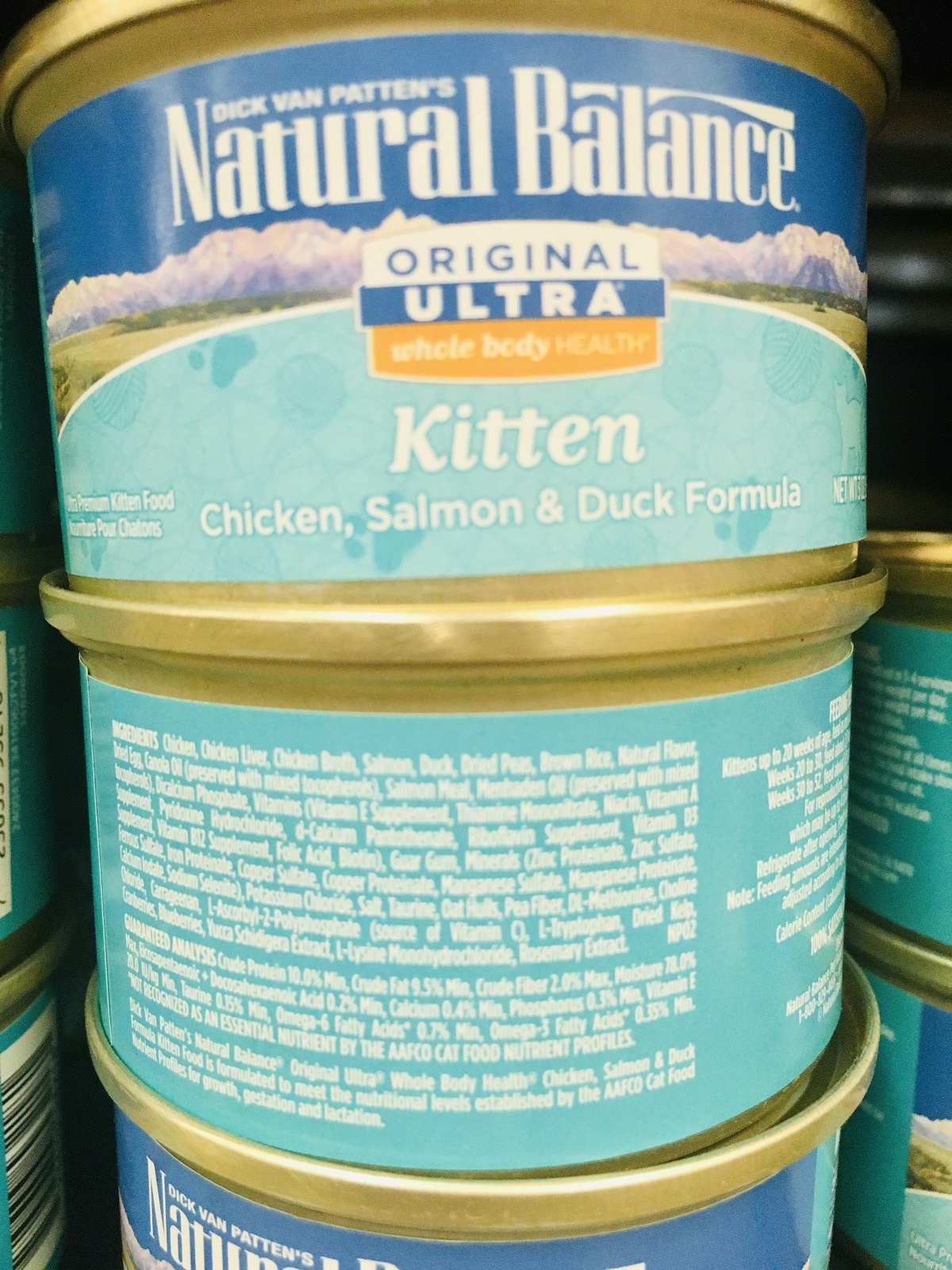
- Product name: Original Ultra Whole Body Health Kitten Formula Chicken, Salmon & Duck
- Formula = 25% rule and a combination so that means less meat
- Meat ingredients = chicken, chicken liver, chicken broth, salmon, duck, salmon meal
- Other ingredients = dried peas, brown rice, natural flavor, dried egg, guar gum, oat hulls, pea fiber, dried kelp, cranberries, blueberries, yucca schidigera extract, and the rest are vitamins and minerals (most of which are synthetic)
This one has even more questionable ingredients.
How can this be healthy for kittens?
Tiki Cat
- Parent company: Whitebridge Pet
- Cat and dog products
- Proof
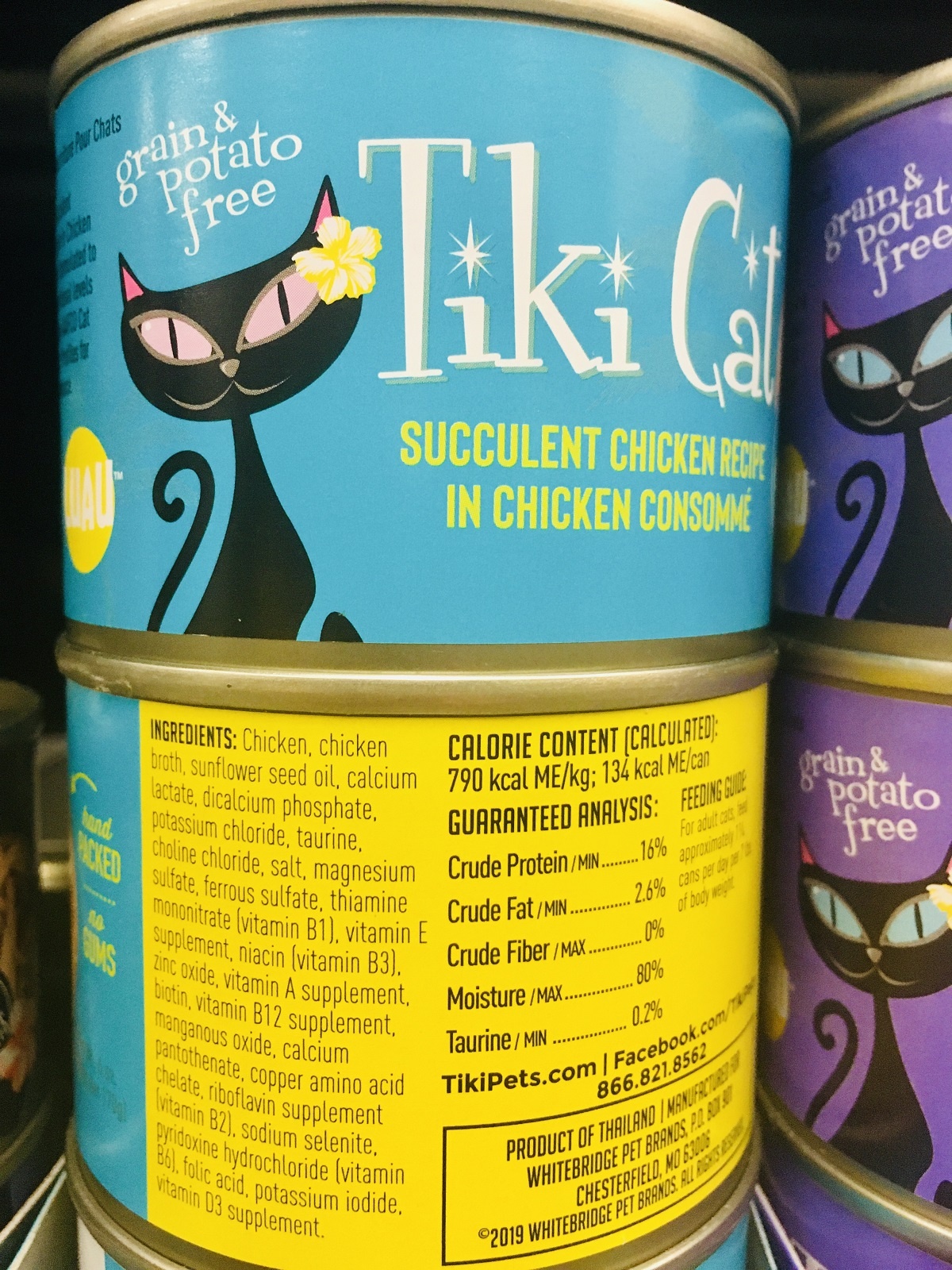
- Product name: Succulent Chicken Recipe
- Recipe = 25% rule
- Meat ingredients = chicken, chicken broth
- Other ingredients = sunflower seed oil and the rest are vitamins and minerals (most of which are synthetic)
This one is mostly broth and synthetic vitamins and minerals.
Solid Gold
- Parent company: Solid Gold Pet
- Cat and dog products
- Proof

- Product name: Tropical Blendz with Salmon & Coconut Oil
- with = 3% rule and a combination so that means less meat
- Meat ingredients = salmon, chicken, tuna
- Other ingredients = tapioca starch, dried egg product, coconut oil, carrots, pumpkin, spinach, guar gum, xanthan gum, carob beach gum, and the rest are vitamins and minerals (most of which are synthetic)
Again, we have fewer meat ingredients packed with undigestible ingredients.
Since the word “with” is involved you have to assume that the meat ingredients are less than 25%. Otherwise, the product would be named “Salmon and Coconut Dinner/Entree/Recipe/etc.”
Wellness
- Parent company: Berwind Corporation
- Pharmaceuticals, plastic products, automotive, and others
- Proof
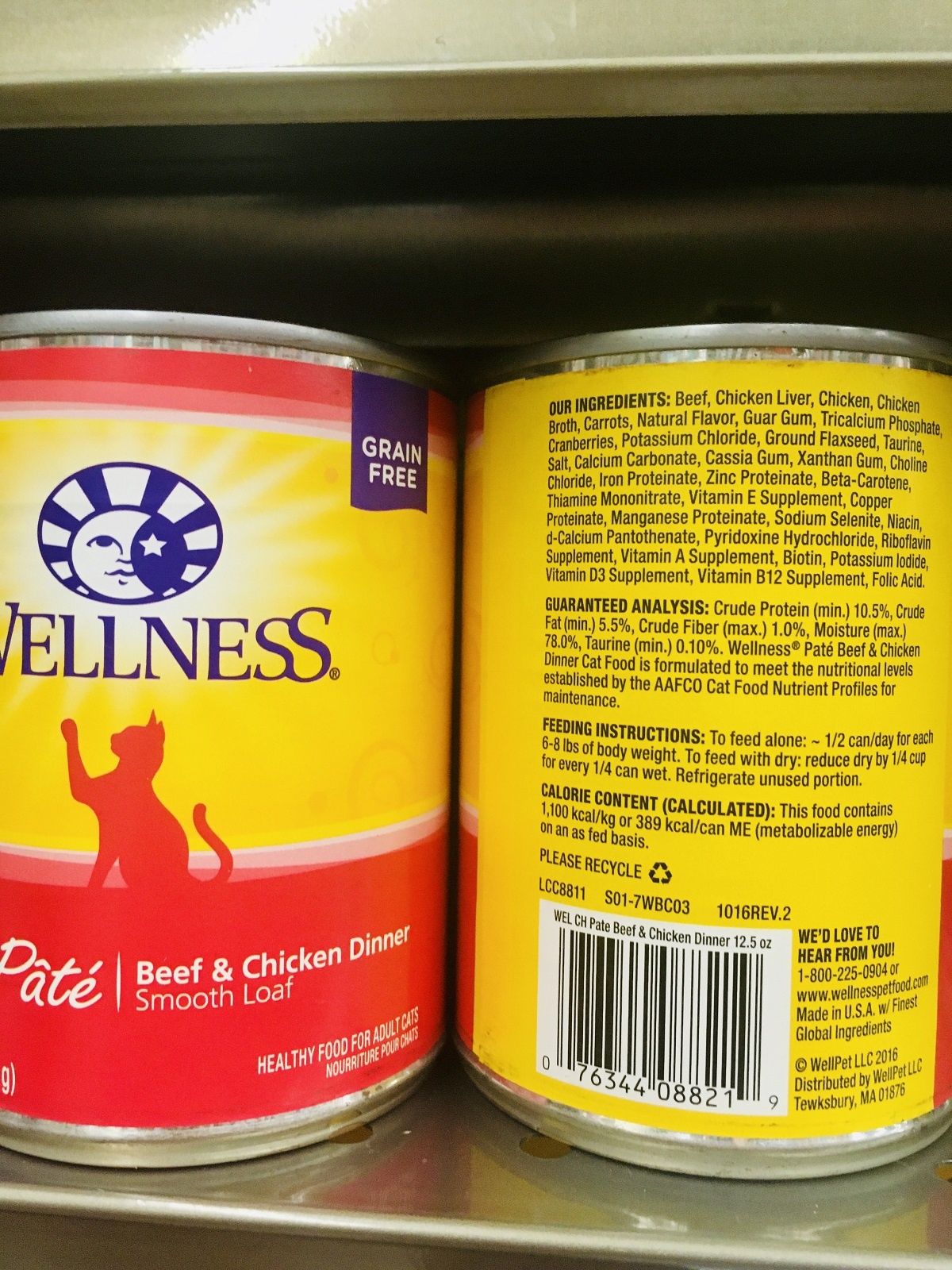
- Product name: Beef & Chicken Dinner
- Dinner = 25% rule and a combination so that means less meat
- Meat ingredients = beef, chicken liver, chicken, chicken broth
- Other ingredients = carrots, natural flavor, guar gum, cranberries, ground flaxseed, cassia gum, xanthan gum, and the rest are vitamins and minerals (most of which are synthetic)
Another goo full of unnecessary ingredients.
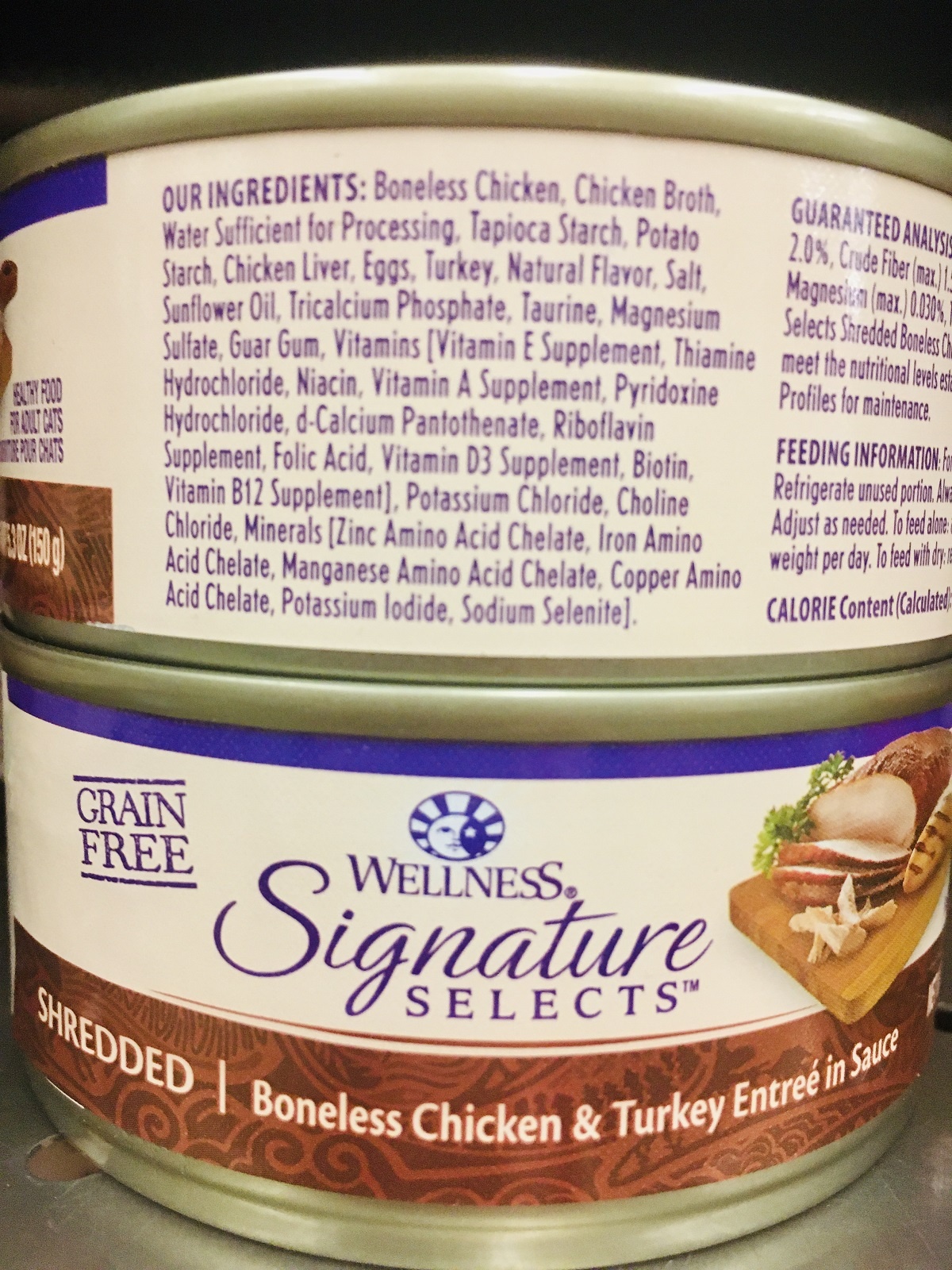
- Product name: Signature Selects Boneless Chicken & Turkey Entree in Sauce
- Entree = 25% rule and a combination so that means less meat
- Meat ingredients = boneless chicken, chicken broth, chicken liver, turkey
- Other ingredients = tapioca starch, potato starch, eggs, natural flavor, and the rest are vitamins and minerals (most of which are synthetic)
Isn’t that so nice that they include fresh-cut meat on the label?
And, they also say grain-free. But, potato starch is extremely high in carbs. Tapioca starch has carb content too.
Whole Hearted
- Parent company: Petco
- Owned by CVC Capital Partners and Canada Pension Plan Investment Board
- Proof and more proof

- Product name: Turkey Recipe in Gravy, Chicken Recipe in Gravy, Beef Recipe in Gravy
- Recipe = 25% rule
- Meat ingredients = turkey: turkey broth, chicken, turkey powder. Chicken: chicken, chicken broth. Beef: beef broth, beef, chicken
- Other ingredients = dried egg product, tapioca starch, sunflower oil, guar gum, locust bean gum, celery powder, and the rest are vitamins and minerals (most of which are synthetic)
Again, we see the same basic ingredients but we have three different foods.
Final thoughts on wet canned cat food
Don’t get me wrong.
Wet canned food is still better than kibble because it has more moisture.
But, it’s not that much better.
Even the FDA says you cannot rely on marketing gimmicks and claims on the label.
Don’t rely on the pictures and claims. Go by the label rules. This is the only way to know what you’re feeding your cats.
All of these different brands use the same ingredients.
Rather than using fresh meat for protein, they bump up protein content with peas, chickpeas, grains, and other ingredients cats aren’t designed to digest.
They use clever marketing to trick you into thinking it’s quality, fresh food.
However, remember that it’s your responsibility to provide the best nutrition to your cats.
A raw homemade diet is best. It’s natural and you control the ingredients.
Did you find these tips useful? Save THIS PIN to your Cat Food board on Pinterest. Be sure to follow me for more cat care tips.
Related articles to wet cat food:
- High Protein Low Carb Wet Cat Food for Weight Loss
- Is Wet Food Bad for Cats Teeth? [Dental Health Guide]
- How Can I Naturally Feed My Cat? Healthy Food 30-Day Challenge
- Cat Food Label Guide [How to Read and Ingredients to Avoid]
- How to Transition Cat Food the Right Way [Complete Guide]
